Organization
- Reconnaissance
53rd reconnaissance regiment - 71st infantry brigade
1st Highland Light Infantry
1st Oxford & Buckinghamshire light infantry
4th Royal Welch fusiliers - 158th infantry brigade
1st East Lancashire regiment
1st/5th Welch regiment
7th Royal Welch fusiliers - 160th infantry brigade
2nd Monmouthshire regiment
4th Welch regiment
6th Royal Welch Fusiliers - Support
1st Manchester regiment - Artillery
81st Field artillery
83rd Field artillery
133rd Field artillery
71st Anti-Tank regiment
116th Light anti-aircraft Regiment - Engineers
- Signals
- Services
History
53rd infantry division is a Welsh territorial unit. Historically, an unit of the same name took part in the First World War. It had fought in the Middle-East and at Gallipoli, before being transformed into territorial unit in 1920.
The aggressiveness of german foreign politics since 1936 launched Great Britain on the way of rearmament. Since 1937, 53rd ID was refitted with new, modern equipment, then became in 1939 a first-line unit. However, it remained in Great Britain during the Phoney war, and did not take part in the operations on the continent. During four years, it remained on British Isles, to train and carry out manoeuvers. From September 1942, it passed under the command of gen. Ross. Normandy would be the first experiment for the division as for its commander…
In Normandy
First units of 53rd ID started to land in Arromanches on June 25th. At once, Welsh division was attached to the 8th Corps which launched out the Epsom operation. Placed in reserve, it however did not have opportunity to intervene, the operation having failed to open the road to Caen. Beginning of July, 53rd ID was attached to the 12th Corps of gen. Ritchie. It was not directly committed in operation Jupiter, but its artillery supported the progression of Wessex infantry toward coast 112.
Mid-July, Dempsey set up operation Greenline, planed to divert the Germans from the east of Orne, where Goodwood was to be launched. On July 15th, in a night attack, 15th and 53rd divisions advanced on Odon valley. 158th brigade was attached to Scottish division and moved towards Evrécy. Supported by tanks of the 34th Tank brigade, it pushed back the 276. and 277. german ID. However, intervention of 9. and 10. SS-PzD, from July 17th on, inflicted heavy losses to both divisions, preventing them to seize any sustainable ground. Whereas Evrécy seemed within reach, operation Greenline was suspended July 19th.
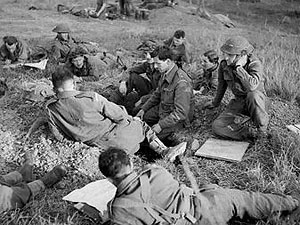
Maintained in the Odon sector, 53rd infantry division got engaged in costly attacks and counter-attacks with no or little strategic weight. For instance, on July 23rd, 160th brigade carried out a raid on the crossroads of Bon-Repos, pushing enemy back to Esquay-Notre-Dame, but this local success occured with no consequence on the gerneral frontline. It is only from August 4th that german withdrawal made it possible for the 12th Corps to resume its advance. 53rd infantry division seized coast 112, previously evacuated by its defenders, then progressed towards Orne, which was reached near Grimbosq.
After crossing Orne on the bridgehead seized by 59th ID on August 8th, 53rd ID continued east, but was successfully retained by a handfull of grenadiers of 271. ID supported by a single Tiger in Bois-Halbout. The fighting went on all the day of August 12th, before the Welsh finally managed to progress. On the right flank of the Canadians, 53rd ID took direction of the south, seized Leffard, and carried out a remarkable progression along the Falaise – Argentan road. It inserted a 6 kilometers coin in german frontline, up to Nécy. It drove back the remains of the german 7. Army in the Falaise pocket from northwestern side.
With the end of the Normandy campaign, 53rd ID took direction of the Seine. It progressed by Evreux, and crossed the river on August 30th.
Belgium and Netherlands
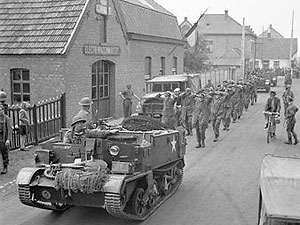
Following the race of the armoured divisions, 53rd ID kept pursuing the retreating german army, clearing pockets of resistance which remained after the first wave of armour. Division liberated Saint-Pol, before moving towards Belgium. It positioned in the neighbourhoods of Antwerp from September 8th.
In preparation for operation Market-Garden , 12th Corps (7th AD, 15th and 53rd ID) was to secure the left flank of the drive carried out by Guards AD. September 17th, supported by a strong artillery barrage, the Welsh attacked starting from their positions around Lommel. Soon after the beginning, they ran against resistance of Kampfgruppe Chill. Germans offered an stubborn defence, which slowed down the division and caused heavy losses. September 19th, the Welsh succeeded in cutting the Turnhout – Eindhoven road, but the fighting depleted its ranks very seriously and required its removal from the frontline and replacement by the Scots of the 15th ID the following day.
After the failure of Market-Garden, 53rd ID performed the task of clearing lower Maas, west of Eindhoven. From October 24th to 27th, it fought to release s’Hertogenbosch. On October 31st, it was transferred east, in the sector of Weert. Reinforced by the Belgian brigade Piron and the 4th armoured brigade, it pushed back the German counter-attacks between Hunsel and Ell.
From November 13th, 53rd ID took engaged in operation Mallard, which was aimed at definitely driving Germans out of the western bank of the Maas. It established a bridgehead on the Wessem canal, then the 158th brigade progressed towards Baexem. November 15th, the 71st brigade arrived in front of the defenses of Roermond, and was comitted to remove the last pockets of resistance in the surroundings. Welsh division was then removed from frontline to rest and refit.
Ardennes and Rhineland
The German offensive in the Ardennes took the Allies by surprise. However, American ability to defend some key positions quickly restablished what initallly looked as a grim situation. British contribution to the defence of Ardennes area materialized in the form of the 30th Corps. Reinforced by several units, among them 53rd ID, it was directed on the northern flank on December 19th. Positioned between Marche and Hotton, Welsh division replaced 2nd US armored division “Hell on wheels” on December 28th. From January 3rd, it counter-attacked enemy positions on Ourthe river. It took Rendeux after a difficult fight, then progressed along the river. After having secured the flank of the British Corps, 53rd ID was withdrawn from the front on January 16th and dropped into reserve to prepare the forcoming invasion of Germany.
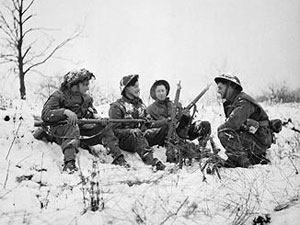
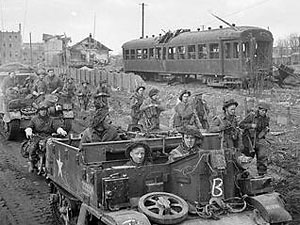
the Rhine. ©IWM B-14833
After three weeks of rest, 53rd ID was committed in the battle of the Rhineland. Still attached to the 30th Corps, it attacked from February 8th in direction of Kleve. Supporting armoured vehicles got quickly bogged down in omnipresent mud, and despite having seized the Brandenburg heights, 53rd division did not manage to capture all its objectives. Quick advance deteriorated into dogfight in the following days, as the resistance of the Germans hardened. Surmounting these obstacles, division progressed through the heart of the forest and crossed the Kleve – Gennep road, before marking a short pause.
Operations in the Rhineland resumed on February 24th, and 53rd ID carried out the offensive in direction of Geldern. It ran up against solids enemy defenses in Hohendorf, managed to circumvent them and capture Weeze the following day. After a few days of additional fighting, it arrived in Kevelaer on March 2nd. The 3rd, it joined American troops north of Geldern, condemning to withdrawal the German forces still present on left bank of the Rhine. From March 7th, 53rd ID was placed in rest, in preparation of the crossing of the Rhine.
In northern Germany
Awaited for a long time because of its symbolic meaning, crossing of the Rhine by the British armies occured on March 24th. Following first assault waves, 53rd ID crossed at the end of March and was launched North-East. From April 4th, with the 52nd ID, it finished to clean the last pockets of resistance in the Teutoburg forest. These wooded heights were defended by some battalions of NCOs, and had effectively slowed down the advance of 7th and 11th armoured divisions in the Ibbenbüren area. It took the Welsh two days of vicious fighting to come to end with german opposition.
53rd ID progressed then towards Weser. After having crossed it, it arrived on April 11th on the Aller at Rethem. From the 11th, it ran up against strong opposition of German marines. Its first attacks failed, and the support of the 5th Royal Tank regiment was needed to dislodge the defenders. Finally, it is after four days of fighting that Welsh division opened its way northwards.
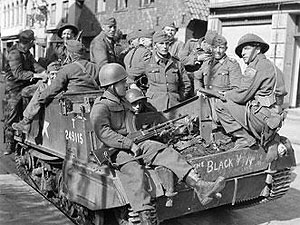
german pockets circumvented by armoured divisions, and made thousands of prisoners. ©IWM BU-3967
Once crossed Weser and Aller rivers, 53rd ID progressed on the left side of the British throw. Advancing towards Hamburg, it met nothing but disorganized pockets of resistance. The only exception was Maschen, where welsh soldiers met a kampfgruppe made up of Hungarian SS supported by tank destroyers. Several attacks were necessary before surroundings of the village were definitively cleaned on April 25th. However, these were the last spasms of an agonizing Reich. On May 3rd, Welsh division reached the suburbs of Hamburg, where it finished the war.
Welsh division was often in charge of ungrateful and not very spectacular roles – suxh as diversion attacks on Odon river in Normandy or on the left flank of the British corridor during operation Market-Garden. However, its involvement in the closing of the Falaise pocket and its advance through the Rhineland despict all the merit of its soldiers.










